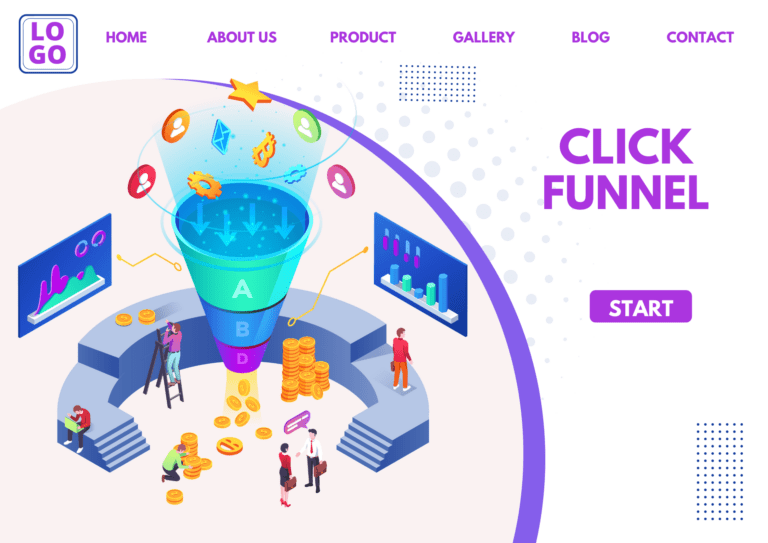What are Click Funnels and How You Can Build Your Click Funnel?
Do you look at different ways to acquire new customers? Have you ever heard of click funnels? A click funnel is a sequence of landing pages with the end goal of converting the visitor into a paid customer. Click funnels are an essential part of both your lead generation and overall marketing strategies.
A click funnel is a defined pathway that businesses want their users to take to become buyers.
Businesses and entrepreneurs commonly use ClickFunnels to advertise and sell their products and services. Meanwhile, others use it to support their online businesses’ efforts to attract new customers.
Let us understand more about click funnels and how you can build a click funnel for your business.

What is the difference between a sales funnel and a click funnel?
Sales Funnel:
A sales funnel is a theoretical model that illustrates the phases a prospective buyer experiences before completing a purchase. It is a graphic depiction of the buyer’s journey, starting from awareness and ending with the ultimate choice and action.
A traditional sales funnel usually consists of the following stages: purchase (bottom of the funnel), interest, consideration, intent, and awareness (top of the funnel). Every step has a distinct function in helping the customer arrive at a purchase decision.
Click Funnels:
A click funnel is a sequence of pages that ends with a conversion. A conversion event can be anything from completing a purchase to downloading an eBook or booking a consultation.
Examples of click funnels include:
- Subscribe to an email newsletter
- Downloading a freebie
- Signing up for a webinar
Different Tiers of Sales Funnels:
The sales funnel has different stages, from getting them aware of the product to converting them into a customer. The levels, or stages, of a sales funnel, typically look like this:
1. Awareness Stage (Top of the Funnel – TOFU):
At this stage of the funnel, potential customers become aware of your brand, products, or services for the first time. It generates interest, draws attention, and increases brand recognition. Draw readers in with blog entries, videos, infographics, and other content on social media.
2. Interest Stage (Middle of the Funnel – MOFU):
This is the second stage when the leads have shown some interest in your products or services and you want to nurture them to make them more interested. Provide insightful content, establish a relationship, and enlighten leads about your offering. Try documents that offer in-depth information, such as case studies, webinars, whitepapers, and ebooks.
3. Consideration Stage (Middle of the Funnel – MOFU):
At this point, potential customers are actively considering your offering, weighing its advantages over competitors, and determining whether it meets their needs. Pitch your product as a viable option, highlight the benefits of what you have to offer, and address particular issues. This is where comparison charts, customer endorsements, product demos, and interactive content can all have an impact.
4. Intent Stage (Bottom of the Funnel – BOFU):
At this stage, leads are nearly ready to make a decision and show buying intent. Try and motivate the leads to do particular tasks, like request a quote, or start a purchase. Provide limited-time deals, live demos, free trials, and individualized consultations.
5. Purchase Stage (Bottom of the Funnel – BOFU):
This is when the lead turns into a customer and the transaction actually takes place. Ensure that the buying process is safe and easy.
Why Should You Have a Click Funnel?
Setting up a click funnel has many advantages for companies and business owners. Here are some reasons why you should consider implementing a click funnel:
1. Effective Sales Process:
Click funnels streamline the sales process by guiding potential customers through a series of steps that increase the likelihood of conversion.
2. Conversion Focused:
The goal of the click funnel’s design is to maximize conversions. The features and templates are designed to persuade users to perform particular actions, like completing a purchase or giving contact details.
3. Flexibility and Customization:
Whether your business’s goals are to sell products, generate leads, host webinars, or promote events, click funnels give you the freedom to create a variety of funnel types.
4. A/B Testing for Optimization:
You can compare various variations on your funnel and optimize for better performance by using ClickFunnels’ A/B testing feature.
Things to keep in mind while creating a click funnel:
1. Know Your Goals and Your Audience:
Understand the needs, issues, and preferences of your target audience. Customize your funnel content to address these aspects and provide a more personalized experience.
Define your funnel’s objectives clearly. Having a clear goal will direct your funnel creation and optimization efforts, whether it is lead generation, product sales, or another objective.
2. Choose the Right Funnel Type:
Various funnels (such as lead generation, webinars, and sales funnels) have different uses. Choose the one that best suits your target audience and business objectives.
3. Create Compelling Headlines and Copy:
Create copy that is compelling and headlines that grab attention. To motivate visitors to proceed through the funnel stages, clearly communicate the value proposition and advantages.
4. Make Use of Great Graphics:
Add elements that are visually appealing, like videos and pictures. Visuals can effectively communicate information and increase engagement.
5. Test and Iterate:
Test your funnel frequently, and make adjustments based on the findings. Make constant improvements to your funnel to improve user experience and performance.
Click funnels provide businesses with an easy-to-use strategy for online marketing by streamlining the complex process of creating and maintaining sales funnels. Take the pointers into consideration before creating your own click funnel. Keep nurturing your audience and leads to help them land a purchasing decision with all the necessary information.
